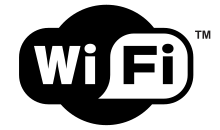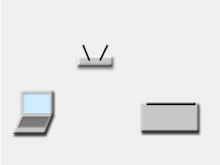Wifi Information
Wi-Fi or WiFi (/ˈwaɪfaɪ/) is technology for radio wireless local area networking of devices based on the IEEE 802.11 standards. Wi‑Fi is a trademark of the Wi-Fi Alliance, which restricts the use of the term Wi-Fi Certified to products that successfully complete interoperability certification testing.
|
The old Wi-Fi Alliance logo
| |
| Introduced | September 1998 |
|---|---|
| Compatible hardware | Personal computers, gaming consoles, televisions, printers, mobile phones |
| Part of a series on |
| Antennas |
|---|
 |
Wi-Fi most commonly uses the 2.4 gigahertz (12 cm) UHF and 5.8 gigahertz (5 cm) SHF ISM radio bands, these bands are subdivided into multiple channels. Each channel can be time-shared by multiple networks. These wavelengths work best for line-of-sight. Many common materials absorb or reflect them, which further restricts range, but can tend to help minimise interference between different networks in crowded environments. At close range, some versions of Wi-Fi, running on suitable hardware can achieve speeds of over 1 Gbps.
Anyone within range with a wireless network interface controller can attempt to access a network; because of this, Wi-Fi is more vulnerable to attack (called eavesdropping) than wired networks. Wi-Fi Protected Access is a family of technologies created to protect information moving across Wi-Fi networks and includes solutions for personal and enterprise networks. Security features of Wi-Fi Protected Access have included stronger protections and new security practices as the security landscape has changed over time.









